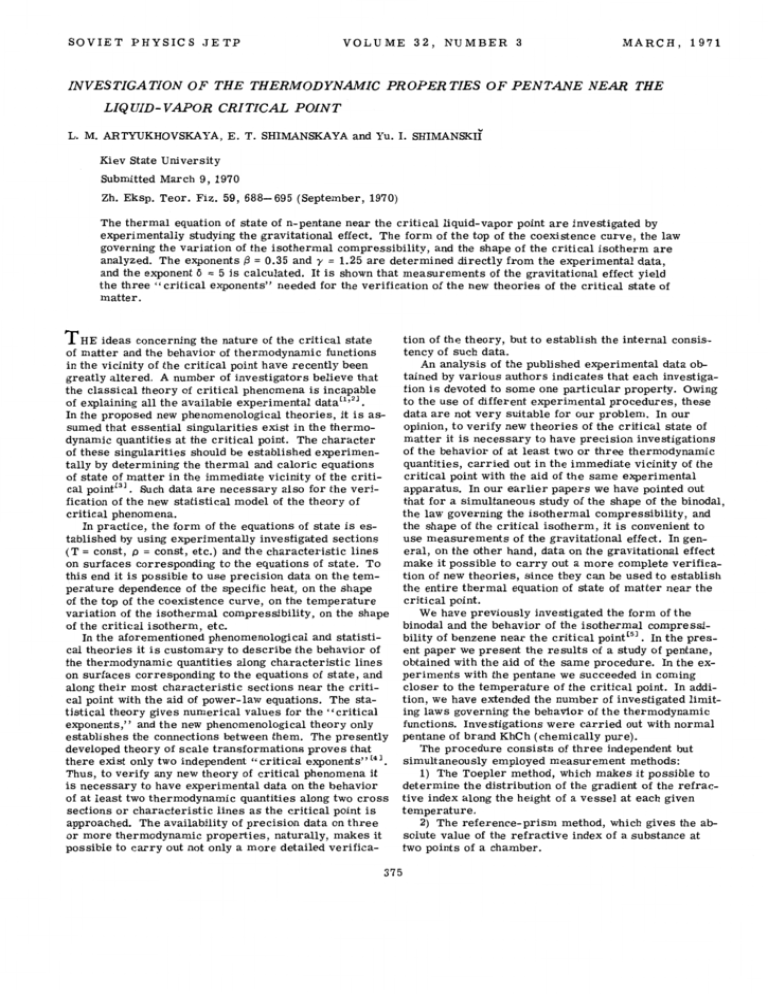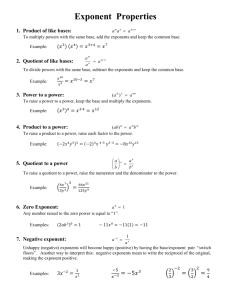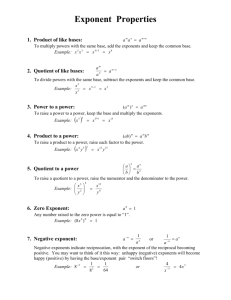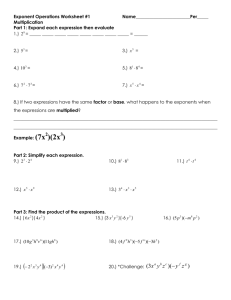Document
advertisement

SOVIET PHYSICS JETP
VOLUME 32, NUMBER 3
MARCH, 1971
INVESTIGATION OF THE THERMODYNAMIC PROPERTIES OF PENTANE NEAR THE
LIQUID-VAPOR CRITICAL POINT
L. M. ARTYUKHOVSKAYA, E. T. SHIMANSKAYA and Yu. I. SHIMANSKII
Kiev State University
Submitted March 9, 1970
Zh. Eksp. Teor. Fiz. 59, 688-695 (September, 1970)
The thermal equation of state of n-pentane near the critical liquid-vapor point are investigated by
experimentally studying the gravitational effect. The form of the top of the coexistence curve, the law
governing the variation of the isothermal compressibility, and the shape of the critical isotherm are
analyzed. The exponents {3 = 0.35 and y = 1.25 are determined directly from the experimental data,
and the exponent o = 5 is calculated. It is shown that measurements of the gravitational effect yield
the three ''critical exponents'' needed for the verification of the new theories of the critical state of
matter.
THE ideas concerning the nature of the critical state
of matter and the behavior of thermodynamic functions
in the vicinity of the critical point have recently been
greatly altered. A number of investigators believe that
the classical theory of critical phenomena is incapable
of explaining all the available experimental data[ 1 ' 2 J.
In the proposed new phenomenological theories, it is assumed that essential singularities exist in the thermodynamic quantities at the critical point. The character
of these singularities should be established experimentally by determining the thermal and caloric equations
of state of matter in the immediate vicinity of the critical point[ 3 J. Such data are necessary also for the verification of the new statistical model of the theory of
critical phenomena.
In practice, the form of the equations of state is established by using experimentally investigated sections
(T = const, p = const, etc.) and the characteristic lines
on surfaces corresponding to the equations of state. To
this end it is possible to use precision data on the temperature dependence of the specific heat, on the shape
of the top of the coexistence curve, on the temperature
variation of the isothermal compressibility, on the shape
of the critical isotherm, etc.
In the aforementioned phenomenological and statistical theories it is customary to describe the behavior of
the thermodynamic quantities along characteristic lines
on surfaces corresponding to the equations of state, and
along their most characteristic sections near the critical point with the aid of power-law equations. The statistical theory gives numerical values for the ''critical
exponents," and the new phenomenological theory only
establishes the connections between them. The presently
developed theory of scale transformations proves that
there exist only two independent "critical exponents" [4 J.
Thus, to verify any new theory of critical phenomena it
is necessary to have experimental data on the behavior
of at least two thermodynamic quantities along two cross
sections or characteristic lines as the critical point is
approached. The availability of precision data on three
or more thermodynamic properties, naturally, makes it
possible to carry out not only a more detailed verifica-
tion of the theory, but to establish the internal consistency of such data.
An analysis of the published experimental data obtained by various authors indicates that each investigation is devoted to some one particular property. Owing
to the use of different experimental procedures, these
data are not very suitable for our problem. In our
opinion, to verify new theories of the critical state of
matter it is necessary to have precision investigations
of the behavior of at least two or three thermodynamic
quantities, carried out in the immediate vicinity of the
critical point with the aid of the same experimental
apparatus. In our earlier papers we have pointed out
that for a simultaneous study of the shape of the binodal,
the law governing the isothermal compressibility, and
the shape of the critical isotherm, it is convenient to
use measurements of the gravitational effect. In general, on the other hand, data on the gravitational effect
make it possible to carry out a more complete verification of new theories, since they can be used to establish
the entire thermal equation of state of matter near the
critical point.
We have previously investigated the form of the
binodal and the behavior of the isothermal compressibility of benzene near the critical point[sJ. In the present paper we present the results of a study of pentane,
obtained with the aid of the same procedure. In the experiments with the pentane we succeeded in coming
closer to the temperature of the critical point. In addition, we have extended the number of investigated limiting laws governing the behavior of the thermodynamic
functions. Investigations were carried out with normal
pentane of brand KhC h (chemically pure).
The procedure consists of three independent but
simultaneously employed measurement methods:
1) The Toepler method, which makes it possible to
determine the distribution of the gradient of the refractive index along the height of a vessel at each given
temperature.
2) The reference-prism method, which gives the absolute value of the refractive index of a substance at
two points of a chamber.
375
~
AR TYUKHOVSKA YA, SHIMANSKA Y A and SHIMANSKII
376
3) The method of free microscopic floats, which
makes it possible to measure the local values of the
density at several points of the vessel.
The foregoing three methods, which supplement one
another, ensure elimination of systematic errors and,
what is particularly important, make it possible to
measure simultaneously and independently both the density of the medium itself and the derivative of the density with respect to the height of the vessel.
To eliminate systematic errors of the measurement
of the gravitational effect in pentane we first measured,
just as in the case of benzene, the refractive index of
pentane in a wide interval of temperatures, including a
detailed determination of n in the region of the critical
point. Figure 1 shows the results of the measurement
of the refractive index of pentane along the coexistence
curve. The data near the vertex of the binodal, i.e.,
under conditions when a noticeable gravitational effect
exists in the medium, correspond to layers of the medium locating directly at the meniscus. The numerical
values of n at the meniscus were obtained by reconciling
the measurements made by the Toepler method with the
measurements of the refractive index, performed with
1,00
t, 'c
200
FIG. I. Temperature dependence of the refractive index of coexisting liquid and vapor n-pentane.
the aid of reference prismsl6 J. It is interesting to note
that the linear-diameter rule holds for the refractive
indices of the liquid and vapor pentane actually holds
near the critical point, up to the very temperature at
which the meniscus vanishes. This fact facilitates the
determination of the refractive index in the critical
state. The refractive index of pentane in the critical
state turned out to be ncr = 1.1275 ± 0.005.
Data on the temperature dependence of the refractive
index together with the corresponding tabulated values
of the density show that the Lorentz- Lorenz refraction
increases monotonically with temperature. The values
of the refraction of pentane in states close to critical
were determined from simultaneous measurements of
the height distribution of the refractive index, carried
out by the Toepler method and by the method of reference prisms, and the local values of the density, determined by the microfloat method. In a narrow temperature interval, where an appreciable gravitational effect
is observed, the specific Lorentz-Lorenz refraction of
pentane turned out to be practically constant at r cr
= 0.357 cm3/ g, whereas for liquid pentane at room
temperature its value is r = 0.350 cm3 /g.
Under conditions close to critical, using the obtained
value of the refraction and the refractive index measured
directly at the meniscus, we calculated the top of the
phase equilibrium curve in terms of the coordinates p
and t (see the table). It is of interest to note that for
the densities of the truly coexisting layers of liquid and
gas, the rule of linear diameter turns out to be valid up
to the very critical point. The use of this rule together
with direct measurements of the density of the investigated substance at different heights and different temperature has made it possible to determine the coordinates of the top of the binodal of pentane: r cr = 0.232
± 0.001 g/ cm 3 and tcr = 196.46 ± 0.01 o C.
The vertex of the binodal, constructed in a doublelogarithmic scale (Fig. 2), makes it possible to establish its exponent. As can be seen directly from the
figure, in a temperature interval 2.0
< -log(IT- Tcri/Tcr) < 4.0, all 25 experimental points
fit well a straight line with a slope {3 = 0.35 ± 0.02. The
Temperature dependence of the refractive indices at
densities of the corresponding liquid and gas at the
meniscus near the critical point of n-pentane
t,
'c
I94.82
194,9I
I95,43
195.51
195.76
195.88
195,97
195,99
I96.03
196,04
196,05
196.06
I96.10
196.12
I96,16
196.18
196.25
196.26
196.33
196.35
196.38
I96.41
196,44
196,46
Pg• g/cm'
-I.64
-I.55
-I.03
-1).95
-Q.7o
-o.58
-0.49
-0.47
--0.43
-0.42
-Q.41
-0.40
-0.36
--0.34
--0.30
-0.28
--0.21
--0.20
--0.13
--0.11
--0.08
--0.05
--0.02
0
I. I645
1.1643
I. I594
1' 1576
1,1545
1,1533
1.1518
I.I5I5
1,1499
1,1498
1,1496
1,1495
1.1489
1. I487
1.1481
1,1472
1.1454
1.1450
1.1419
1,1415
1 ,I402
1,1380
1,1366
1.1275
I .09I3
I.09I4
1,0958
1.0977
1,1009
1.1016
1.1030
1' 1036
1 '1043
1.1047
1.1049
1.1053
1.1060
1.1062
1,1064
1.1076
1 '1093
1.1096
1.1122
1.1138
1,1159
1.1173
1' 1184
1.1275
0,2972
0,2968
0.2883
0,2852
0,2798
0.2777
0,2750
0,2745
0.2717
0.2715
0.2712
0.2710
0,2700
0.2696
0.2686
0.2670
0,2638
0.2631
0.2577
0,2570
0,2547
0.2508
0.2483
0.2320
0. I676
0. I678
0.1757
0,179I
o, I849
0 . 1861
0.1886
0.1897
0,1909
0.1917
0.1920
0.1927
0.1940
0,1943
0.1947
O.I969
0.1999
0.2004
0.2051
0.2079
0,2117
0.2142
0.2161
0.2320
377
THERMODYNAMIC PROPERTIES OF PENTANE
tion of state in the region of the critical poine>. A shortcoming of this equation is the postulate that the singularities occurring in the sections p = p cr and T = T cr
are additive. In this sense, Eq. (2) is a generalization
of the equation of Landau and Lifshitzl 7 l.
Equation (2) with T < T cr has an analytic continuation in the metastable and unstable regions. Therefore
to find the densities of the coexisting phases at a specified temperature it is necessary to use the conditions
that the specific Gibbs potentials and the pressures be
equal. The coexistence curve is obtained in the form
--i~-
1,0
(2
(3)
I
L.c--~------f,-__j
4,0
J,O
2,0
50
-lg [IT-TeriiTcrl
FIG. 2. Top of the coexistence curve of n-pentane, plotted in a loglog scale.
experimental points obtained closer to the critical
point are subject to much larger errors in the determination of (Tcr- T)/Tcr; these errors are directly
reflected in the plot of Fig. 2. However, even when
these errors are taken into account, the obtained experimental points cannot lead to an increase of the slope
of the straight line, as would be necessary to obtain
agreement with the classical theoryl 7 J. To discuss the
remaining results it is therefore logical to use the
thermal equations of state, which follow from the new
phenomenological theories.
The most perfect is the Widom-Griffiths equationl 3 J,
which can be written in the form
~'f-1t16-lth(-"t-)
C!'er- ~
~
lsi''~
'
( 1)
where t.cp is the difference between the specific Gibbs
potential at the arbitrary point cp( p, T) and its value on
the critical isochore cp( p cr, T), cp cr is the value of the
specific Gibbs potential at the critical point,
~ = (P- Per)!Per is the relative change of the density,
and T = (T- Tcr)/T cr is the relative change of the absolute temperature.
This thermal equation makes it possible, in accordance with the experimental data, to vary somewhat the
character of the singularities of the thermodynamic
quantities at the critical point and to modify the description of the behavior of these quantities in its vicinity. However, a comparison of the Widom- Griffiths
equation with the entire aggregate of experimental data
on the thermal equation of state is made difficult by the
uncertainty of the function h( T/ I~ 11/ t1).
It seems to us that the following equation
(2)
where the notation is the same as in (1), and in addition
a> 0, b > 0, y ~ 1, and o > 1 (y and o need not necessarily be integers), while allowing sufficient freedom in
the choice of the character of the singularities of the
thermodynamic quantities and having sufficient certainty
of the functional relations, is the most suitable for the
discussion of the experimental data on the thermal equa-
hence the "critical exponent" of the phase-equilibrium
curve turns out to be f3 = y / (o - 1), in agreement with
the conclusions of the theory of Widom and Griffithsl 3 J
From (2) we can obtain an equation for the isothermal
compressibility of the medium KT, in the form:
~=(~)
p Kr
8p
r
='l'cr{!...[ ~q>]} =(jlcr{ai,;I?-Lt+bl£16-1}.
Per 8s <fer
T
Per
(4)
At a fixed temperature, when T > T cr• the quantity p 2 KT
reaches its maximum value on the critical isochore, but
if T < T r the maximum is reached on the coexistence
curve. ffor T > T cr we obtain the following equation for
p 2 KT along the critical isochore:
'l'crll
<Per
- ,1- = a
- ' 7 - 1 (-r)=a-r?.
Per K,.
Per
p cr
Along the coexistence curve at T
for p 2 KT is of similar form:
1
({ler
--=a~(llp2Kr
Per
< T cr•
(4a)
the relation
1)( - r )'.
(4b)
We emphasize that the obtained form of the laws for the
coexistence curve (3) and for the isothermal compressibility (4) is overdefined by the assumption of additivity
of the singularities over the cross sections p = Per and
T = T cr• an assumption used in writing down Eq. ( 2).
From the assumption that Eq. (2) is valid, it follows
also that the exponents y and the coefficients a in the
equations governing the isothermal compressibility,
( 4a) and ( 4b) are equal.
The ''critical exponent'' y can be determined from
simultaneous measurements of the local values of the
density and of the refractive- index- gradient distribution
curves. According to the theory of the gravitational
effect, p 2 KTg = -(Bp/Bz)T. The density gradient is determined directly by the Toepler method from the inclination of the rays t.a in the focal planel 9 J:
6n
-:-..,-..,:-;:-,-=~
r(n 2
2)'Wf
+
I'> a.
'
(5)
here n is the refractive index, r the specific refraction,
f the focal length of the objective of the Toepler optical
system, W the horizontal thickness of the investigated
layer, and z the vertical coordinate of the layer. The
factor 6n/r(n 2 + 2) 2 varies only 3-4% in a temperature
interval on the order of 200°, and in the vicinity of the
critical point, where the gravitational effect is obllEq. (2) is similar to the equation proposed by Alekhin and
Chalyi [ 8 ].
ARTYUKHOVSKA YA, SHIMANSKA YA and SHIMANSKII
378
(maxiClal)"', 1/mm
we have employed a somewhat indirect method, based
on the use of Eq. (2) or, more accurately, of Eqs. (4a)
and (4b) that follow from (2). Dividing the second of
these equations by the first, we obtain for equal values
ofiT-Tcrl
(6)
~·
o,s
~e,·c 1.2
FIG. 3. Temperature dependence of the quantity (maxlllalr 1 ,
which is proportional to the reciprocal of the isothermal derivative
p 2 KT of the thermal equation of state.
tg (mai I~
aIr'
-0,5,----~-~-,------,.-----,
FIG. 4. Temperature dependence of (maxlllalr 1 co p 2 KT in a
log-log scale.
2.5
2,0
served, it can be regarded as a constant coefficient.
Thus, the quantity p 2KT, which is a derivative of the
thermal equation of state, turns out to be proportional
to the directly measured inclination ~a in the region of
the critical point.
For an experimental determination of the exponent y•
in the equation for (p 2KTf 1 in the high-temperature
region along the critical isochore, it suffices to establish the law governing the variation of the inverse quantity, max /~a/, on approaching the critical temperature.
The determination of the analogous exponent yi reduces
to an analysis of the change of (max J~al)- 1 in any of the
phases, at temperatures below critical. Figure 3 shows
the experimental temperature dependence of the reciprocal quantity max J~aJ for a liquid at T < T cr• in the
analogous relation for the high-temperature region.
The nonlinearity of the discussed laws contradicts the
predictions of the classical theory.
To find the exponent in the equations for the temperature dependence of p 2 KT, just as in the analysis of
the coexistence curve, it is convenient to use a log-log
scale. It is seen from Fig. 4 that in the temperature
interval2.5 < -log(J~Ti/Tcr) < 4.0, all the experimental points lie, within the limits of measurement accuracy, on two parallel straight lines with slope y• ~ y= 1.25 ± 0.10, which is in fair agreement with the predictions of the new statistical theories.
We were unable to measure directly the critical
isothermal with the required accuracy, even using our
own method, owing to the difficulties in measuring large
deflections of the optical rays near the critical point.
Therefore, to find the exponent of the critical isotherm
The exponent of the critical isotherm, calculated on the
basis of (6), turned out to be close to o = 5, which differs appreciably from the classical value o = 3 and
coincides with the results of the analysis of the experimental data of some other workerslloJ. The error in
our method of the determination of the exponent o was
much larger than in the case of the determination of {3
and y. Taking into account the average error, we should
assume o = 5.0 ± 0.5.
Thus, from experimental data on the gravitational
effect in pentane, we have obtained the exponents of the
coexistence curve and of the isothermal compressibility,
and also the exponent of the critical isotherm. This
raises the question whether these exponents can be regarded as ''critical exponents'' of the limiting laws. In
other words, we can expect changes in the numerical
values of these exponents on coming closer to the critical point and when the latter is determined more accurately.
In our opinion, a comparison of the plots of the
properties measured at T < T cr with those measured at
T > T cr indicates that an increase in the accuracy
with which the critical temperature is measured will
have no significant influence on the exponents of the investigated laws in the investigated temperature intervals. At the very most, the width of the absolute error
may slightly increase. As to the influence of a closer
approach to the critical point, we can advance the following argument. In the investigations of pentane we
have succeeded in coming closer to the critical temperature point by approximately one order of magnitude
than in the case of the investigation of benzenel 5 J. This
had no noticeable effect on the form of the discussed
laws. Within the limits of errors, the measured numerical values of the exponents {3 and y were the same for
both substances. This gives grounds for expecting the
obtained exponents to retain the same value also closer
to the critical point.
By determining with the aid of identical measurements the two critical exponents f3 and y and by calculating the third critical exponent o, we can verify the
relations between them, proposed by Widom, and to
calculate the two fundamental critical exponents of the
theory of scale transformationu- 4J. Widom' s relations
(7)
are satisfied in the best manner if, within the limits of
errors of our measurements of both pentane and benzene, we assume the following critical exponents:
f3 = 0.33, y = 1.3, and o = 5. From the Pokrovski1 relationl4J
3-x
!3=-y
2x-3
Y
y=---,
11=--x-
3-x
( 8)
we get x = 2.49 andy = 1.53.
Using the formulas from Pokrovski1' s table, we can
THERMODYNAMIC PROPERTIES OF PENTANE
calculate the remaining critical exponents. All are close
to the results of calculations of the three- dimensional
Ising model. It seems to us, however, that there are
still no grounds for assuming that the Ising model is
fully representative of reality. At the same time, we
wish to emphasize that further precision investigations
of the gravitational effect can contribute to a solution of
this problem.
1 M.
Fisher, The Nature of the Critical state, 1968.
Critical Phenomena, Proc. of Conf., Washington,
D. C., 1965, National Bureau of Standards, Miscellaneous
Publication, No. 273, 1966.
3 B. Widom, J. Chern. Phys. 43, 3898, 1965. R. B.
Griffiths, Phys. Rev., 158, 176 (1967).
4 V. L. Pokrovskii, Usp. Fiz. Nauk 94, 127 (1968L
[Sov. Phys.-Usp. 11, 66 (1968)]. L. P. Kadanoff, W.
Gotze, D. Hamblen, R. Hecht, E. A. S. Lewis, V. V.
Palciauskas, M. Rayl, and J. Swift, Rev. Math. Phys. 39,
395 (1967).
2
5
379
L. M. Artyukhovskaya, E. T. Shimanskaya, and Yu.
I. Shimanski1, Ukr. Fiz. Zh. 15, No. 10 (1970).
6 E. T. Shimanskaya and Yu. I. Shimanski1, Visn.
Kiiv. univ. ser. fiz. khim. No. 7, 35 (1967). E. T.
Shimanskaya, Opt. Spektr. 29, 27 (1967).
7 L. D. Landau and E. M. Lifshitz, Statisticheskaya
fizika (statistical Physics), Nauka, 1964 [AddisonWesley].
8 A. V. Chalyl' and A. D. Alekhin, Zh. Eksp. Teor.
Fiz. 59, 337 (1970) (Sov. Phys.-JETP 32, 181 (1971)].
9 E. T. Shimanskaya, Yu. I. Shimanski:l, and A. Z.
Golik, in: Kriticheskie yavleniya i flutkuatsii v
rastvorakh (Critical Phenomena and Fluctuations in
Solutions), AN SSSR, 1960, p. 171.
10 M. S. Green, Vicentini Missoni, and J. M. Levelt
Sengere, Phys. Rev. Lett. 18, 1113 (1967).
Translated by J. G. Adashko
80






